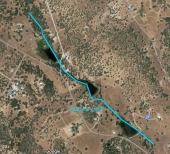posted 1 year ago
I would recommend the following checklist:
1. Water.
Check if the land is in good water area.
Is it drinkable right from the well or needs some treatment? If the latter is the case please do not buy such a land. You will be relying on chemicals/filters for entire life. Watering with salty water will pollute your soil.
How deep are the wells? Deep wells will be expensive and usually will have lower yield.
What are the average yields of wells in the area? If it's less than 5 gallons per minute then it's problematic to irrigate.
Does it have some stream? If it does not dry out in dry season, it may be a great asset.
What is average precipitation? If it's less than 20 inches then things start becoming difficult.
Does it get snow that stays on the ground? In some cases it may be a positive asset that would help growing for example winter grains.
2. Terrain.
Is it steep? If it is, then usually the soil will be very shallow.
Does it have visible rocks? If it does then the soil will be very shallow.
Is it located in some valley? If it is, then it's possible that you will have to deal with temperature inversions, experiencing late (even very late) and early freezes and then possibly a lot of night freezes throughout the winter,
Does it have southern or northern exposure? In places with too much sun, northern exposure is preferable to grow anything without too much difficulty.
Does it have vegetation? If it does it means there is some water and then potential shade for your plants. However if the land is part of a forest or just has a lot of trees, you will have to cut some and dig the roots and it's a lot of work.
If the terrain is very rugged, it will be expensive to develop it - cut the building pads, build driveways.
Is it located in flood zone? Seems like something not important, but after I saw the rain in 2023 and the tiny creek I have turned into rushing 8 meter wide stream, destroying the banks, pulling big pieces of lumber, damaging fences, then I changed my opinion
3. Soil.
Is it deep? You can use USDA soil maps to find out what is there.
Does it have gravel or too much clay in its profile? Both are limiting factors.
Does it have adverse chemicals that will make it too alkaline?
4. If your job or lifestyle requires to have the phone, check if you are in area covered by some cellular network.
5. How far is it to nearest normal grocery store?
How far is it to some home improvement stores, quarries, lumber yards?
Is the access road passable by heavy trucks that may bring your building materials or concrete, or drill the well, etc?
6. Wildlife.
Does the area have bears, pumas? If it does, you will have to deal with them at some point, especially if you grow something tasty (plants, honey, animals).

 1
1




 2
2




 1
1





 2
2








 2
2




 2
2










